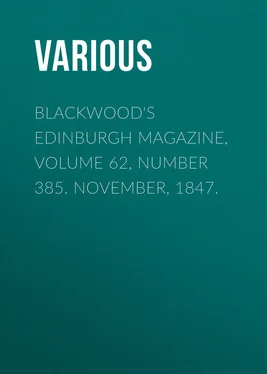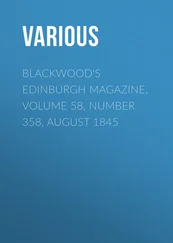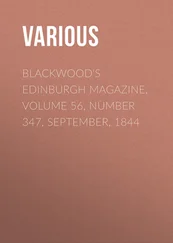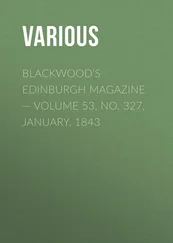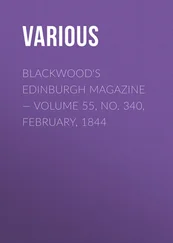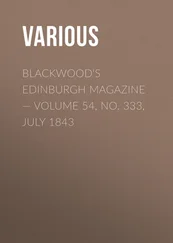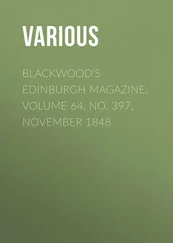Various - Blackwood's Edinburgh Magazine, Volume 62, Number 385. November, 1847.
Здесь есть возможность читать онлайн «Various - Blackwood's Edinburgh Magazine, Volume 62, Number 385. November, 1847.» — ознакомительный отрывок электронной книги совершенно бесплатно, а после прочтения отрывка купить полную версию. В некоторых случаях можно слушать аудио, скачать через торрент в формате fb2 и присутствует краткое содержание. Издательство: Иностранный паблик, Жанр: periodic, foreign_edu, Путешествия и география, на английском языке. Описание произведения, (предисловие) а так же отзывы посетителей доступны на портале библиотеки ЛибКат.
- Название:Blackwood's Edinburgh Magazine, Volume 62, Number 385. November, 1847.
- Автор:
- Издательство:Иностранный паблик
- Жанр:
- Год:неизвестен
- ISBN:нет данных
- Рейтинг книги:4 / 5. Голосов: 1
-
Избранное:Добавить в избранное
- Отзывы:
-
Ваша оценка:
- 80
- 1
- 2
- 3
- 4
- 5
Blackwood's Edinburgh Magazine, Volume 62, Number 385. November, 1847.: краткое содержание, описание и аннотация
Предлагаем к чтению аннотацию, описание, краткое содержание или предисловие (зависит от того, что написал сам автор книги «Blackwood's Edinburgh Magazine, Volume 62, Number 385. November, 1847.»). Если вы не нашли необходимую информацию о книге — напишите в комментариях, мы постараемся отыскать её.
Blackwood's Edinburgh Magazine, Volume 62, Number 385. November, 1847. — читать онлайн ознакомительный отрывок
Ниже представлен текст книги, разбитый по страницам. Система сохранения места последней прочитанной страницы, позволяет с удобством читать онлайн бесплатно книгу «Blackwood's Edinburgh Magazine, Volume 62, Number 385. November, 1847.», без необходимости каждый раз заново искать на чём Вы остановились. Поставьте закладку, и сможете в любой момент перейти на страницу, на которой закончили чтение.
Интервал:
Закладка:
"The beach was composed of coarse fragments of worn corals and shells bleached by the weather. At the back of it, a ridge of the same materials four or five feet high, and as many yards across, completely encircled the Island, which was not a quarter of a mile in diameter. Inside this regular ridge was a small sandy plain. The encircling ridge was occupied by a belt of small trees, while on the plain grew only a short scrubby vegetation, a foot or two in height. Some vegetable soil was found, a few inches in thickness, the result of the decomposition of vegetable matter and birds' dung. On the weather side of the island was a coral reef of two miles in diameter, enclosing a shallow lagoon. In this lagoon were both sharks and turtles swimming about. The island was stocked with sea-fowl, and the trees were loaded with their nests."
It was a sort of bird-paradise, into which the foot of man, the destroyer, had probably never entered before.
There is considerable beauty in a small coral reef, when seen from a ship's mast-head, at a short distance, in clear weather. A small island with a white sand-beach and a tuft of trees, is surrounded by a symmetrically oval space of shallow water, of a bright grass-green colour, enclosed by a ring of glittering surf as white as snow; immediately outside of which is the rich dark blue of deep water. All the sea is perfectly clear from any mixture of sand or mud. It is this perfect clearness of the water which renders navigation among coral reefs at all practicable; as a shoal with even five fathoms water on it, can be discerned at a mile distance from a ship's mast-head, in consequence of its greenish hue contrasting with the blue of deep water. In seven fathoms water, the bottom can still be discerned on looking over the side of a boat, especially if it have patches of light-coloured sand; but in ten fathoms the depth of colour can scarcely be distinguished from the dark azure of the unfathomable ocean. This bed of reefs stretches along the coast of Australia, and across Torres Strait, nearly to the coast of New Guinea, a distance of one thousand miles!
One of the charms of Natural History is, that it gives a perpetual interest to Nature, – that things, to the common eye of no attraction, have the power of giving singular gratification; and that, in fact, the intelligent naturalist is indulged with a sense of beauty, and an accession of knowledge in almost every production of nature. We cannot avoid quoting the example in the writer's own words. The subject was a block of coral, accidentally brought up by a fish-hook from the bottom of one of the anchorages. Nothing could have been less promising, and any one but a naturalist would have pronounced it to be nothing but a piece of rock, and have flung it into the sea again. But what a source of interest does it become in the hands of the man of science.
"It was a mere worn dead fragment, but its surface was covered with brown, crimson, and yellow Nulliporæ , many small Actinæ , and soft branching Corallines , Flustra , and Eschara , and delicate Reteporæ , looking like beautiful lace-work carved in ivory. There were several small sponges and Alcyonia , seaweeds of two or three species, two species of Comatula , and one of Aphiura , of the most vivid colours and markings, and many small, flat, round corals, something like Nummulites in external appearance.
"On breaking into the block, boring shells of several species pierced it in all directions, many still containing their inhabitants; while two or three Nereis lay twisted in and out among its hollows and recesses, in which, likewise, were three small species of crabs."
If it should be supposed that the receptacle or nidus of all those curious and varied things was a huge mass of rock, we are informed that, —
"The block was not above a foot in diameter, and was a perfect museum in itself, while its outside glared with colour, from the many brightly and variously coloured animals and plants. It was by no means a solitary instance; every block which could be procured from the bottom, in from ten to twenty fathoms, was like it."
The reflection on this exuberance of nature is striking and true. – "What an inconceivable amount of animal life must be here scattered over the bottom of the sea! to say nothing of that moving through its waters; and this through spaces of hundreds of miles: every corner and crevice, every point occupied by living beings, which, as they become more minute, increase in tenfold abundance."
And let it be remembered, too, that those creatures have not merely life, but enjoyment; that they are not created for any conceivable use of man, but for purposes and pleasures exclusively suited to their own state of existence; that they exist in millions of millions, and that the smallest living thing among those millions, not merely exceeds in its formation, its capacities, and its senses, all that the powers of man can imitate, but actually offers problems of science, in its simple organisation, which have baffled the subtlest human sagacity since the creation, and will probably baffle it while man treads the globe.
In the navigation along the coast, the officers had frequent meetings with the natives, who seemed to have known but little of the English settlements, for their conduct was exactly that of the savage. They evidently looked with as much surprise on the ships, the boats, and the men, as the inhabitants of Polynesia looked upon the first navigators to their shores. They were all astonishment, much craft, and a little hostility on safe occasions.
But some parts of the coast still invite the settler, and the communication of this knowledge from a pen so unprejudiced as that of the voyager, may yet be a service in directing the course of colonisation. We are told that the tract of coast between Broad Sound and Whitsunday Passage, between the parallels of twenty-two degrees fifteen seconds, and twenty degrees twenty seconds, exhibits peculiar advantages. Superior fertility, better water, and a higher rise of tide, are its visible merits. A solid range of hills, of a pretty uniform height, cuts off from the interior a lower undulating strip of land from five to ten miles broad, the whole seeming to be of a high average fertility for Australia. The grass fine, close, and abundant; the timber large-sized and various. The coast is indented with many small bays and inlets. The great rise and fall of tide is, of course, admirably adapted for the construction of docks for the building and repair of ships.
Nor are those advantages limited to the soil. The coast is protected, as well as enriched and diversified, by numerous small islands, lofty, rocky, and picturesque, covered with grass and pines.
The most vexatious part of the narrative relates to the natives; whether they have been molested by the half-savage whalers, or are treacherous by habit, it was found necessary to be constantly on the watch against their spears. The parties who were sent on shore merely to take astronomical observations, were assailed, and were sometimes forced to retaliate. Instead of the generally thin and meagre population of Australia, some of those tribes were numerous, and of striking figure, especially in the neighbourhood of Buckingham Bay. These were friendly and familiar at first, often coming to the ships; and so much confidence was at last placed in them, that the boats' crews neglected to take their arms with them when they went for water, or to haul the seine; but this was soon found to be perilous confidence.
"On the very last night of our stay, after catching a good haul of fish, and distributing some of them to the natives, the boats were suddenly assailed by a shower of spears and stones from the bushes. The boatswain was knocked down by a large stone and much hurt. Luckily, one of the men had a fowling-piece, and after firing it without producing any effect, a ball was found in the boat, with which one of the black fellows was hit, and the attack immediately ceased.
Читать дальшеИнтервал:
Закладка:
Похожие книги на «Blackwood's Edinburgh Magazine, Volume 62, Number 385. November, 1847.»
Представляем Вашему вниманию похожие книги на «Blackwood's Edinburgh Magazine, Volume 62, Number 385. November, 1847.» списком для выбора. Мы отобрали схожую по названию и смыслу литературу в надежде предоставить читателям больше вариантов отыскать новые, интересные, ещё непрочитанные произведения.
Обсуждение, отзывы о книге «Blackwood's Edinburgh Magazine, Volume 62, Number 385. November, 1847.» и просто собственные мнения читателей. Оставьте ваши комментарии, напишите, что Вы думаете о произведении, его смысле или главных героях. Укажите что конкретно понравилось, а что нет, и почему Вы так считаете.
